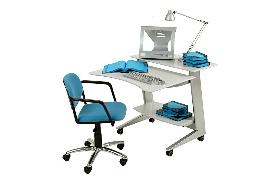Introduction
JAN provides this information as a way to share accommodation situations and solutions from STEM related jobs. For a more in depth discussion, contact JAN directly.
Situations and Solutions:

A design engineer with chronic fatigue syndrome had difficulty working full-time.
He was allowed to work-at-home three days a week.

A chemical process plant worker was limited in his ability to turn large wheel valves due to a back injury.
The worker was accommodated with a specialty tool designed to decrease torque on wheel valve handles.

A computer programmer with Hepatitis B was experiencing fatigue and nausea, which resulted in problems commuting.
The employer provided a modified schedule and gave the employee an option to work from home.

A drafter with arthritis in his knees was having difficulty accessing his work-site.
He was accommodated with a reserved parking space close to the building, a first floor office, and push pad activated power doors.

A field geologist who was deaf and worked alone in remote areas was unable to use two-way radio communication to report his findings.
Text telephone technology was used to allow the geologist to communicate using a cellular telephone.

A physician with muscular dystrophy was having problems getting up from a seated position after consulting with patients.
The individual was accommodated with a lift cushion for his chair.

A pharmacist was having difficulties standing for eight hours a day on a tile floor.
This employee was responsible for filling prescriptions for medication. The work area was carpeted using extra padding, which assisted in reducing fatigue and a sit/stand/lean stool was purchased to assist employee when standing. Employee was also permitted to take frequent rest breaks throughout the day. This was possible since the employee cut his lunch hour down to 30 minutes, which provided him with 30 minutes that could be used at other times of the day whenever a break was needed. Also another pharmacist was available to cover his breaks.

A computer programmer with stuttering found communication by telephone to be particularly difficult.
He asked that when face-to-face interactions were not possible, his supervisor utilize e-mail and instant messaging instead of the telephone and that he also be allowed to use these methods of communication with his coworkers. The employer agreed.

A computer programmer experienced migraines that were triggered by the noise level in his cubicle and the overhead fluorescent lighting.
As an accommodation, his employer provided him with a noise canceling headset, disabled the fluorescent light above his cubicle, and provided natural task lighting.

A chemistry professor used a wheelchair due to a spinal cord injury.
The existing chemistry lab was designed to accommodate students at a standing height. The college could not remodel the entire lab so purchased an elevating wheelchair.

An engineer with muscular dystrophy had difficulty grasping frequently used files.
He was accommodated with a desktop carousel.

A drafting engineer had third degree burns to 80% of his body.
He was limited in sitting for extended periods. He was accommodated with an ergonomic workstation, including a sit/stand work station.

Due to Alzheimer's disease, a project manager for an engineering firm was increasingly unable to keep track of and manage all of the individual components that were involved in the project.
After careful consideration, he spoke to his employer about the difficulties he was having and asked to be placed back into a team position where he would only be involved with one aspect of the project instead of coordinating the entire project. His employer agreed and as it was near to the end of the current project, felt that they could very easily do some restructuring and find a position for him on one of the teams.

An engineer working for a large industrial company had to undergo radiation treatment for cancer during working hours.
She was provided a flexible schedule in order to attend therapy and also continue to work full-time.

An engineer with color vision deficiency needed to work on multiple projects.
The engineering firm where he worked printed materials related to each project on a different color of paper in order to help everyone stay organized. The engineer was not able to distinguish colors, and did not find the system useful. A consultant from JAN discussed numerous accommodation ideas including organizing the paperwork differently, handwriting the color or first letter of the color in the upper right corner of the master copy so that it would be there on all photocopies, and providing a handheld color identifier to the engineer so that he could use it identify the color of each paper on his own. The employer provided a high-end handheld color identifier.

An engineer with Parkinson’s disease was having difficulty concentrating and communicating.
The individual was accommodated with a quiet office free from distractions. In addition, her supervisor implemented a policy of scheduled interruptions with written reminders and assignments. The individual was also provided with a communication device.

An engineer with epilepsy had difficulty managing multiple tasks.
JAN suggested color-coding on-going projects, using wall charts to track progress, and prioritizing tasks for the employee.

An engineer with multiple sclerosis was experiencing heat sensitivity.
She was provided a private office where the temperature could be lower than in the rest of the facility. She was also encouraged to communicate with coworkers by telephone or e-mail when possible to reduce the amount of walking she had to do.
According to the U.S. Department of Labor, STEM fields have become increasingly central to United States' economic competitiveness and growth. There has been great effort to prepare an adequate supply of qualified workers for these fields. For new workers with disabilities, and as our working population ages, it is imperative to consider providing job accommodations to enhance the productivity of these valuable workers.

